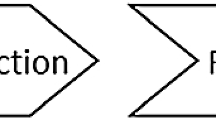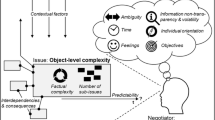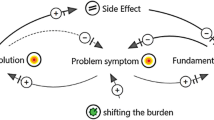Abstract
Negotiations generally tend to focus efforts on attaining optimality in single-problem contexts that are ad hoc, disparate and temporary in nature. Once negotiators reach agreement, the process usually attains closure and the long-term impact of the outcome is rarely considered. In organizational settings, decisions involving quid pro quos are, however, made on a continuous basis. Since organizational environments are constantly in flux, negotiated solutions that appeared successful on a given problem at first might no longer work out to be effective in the long run. We postulate that organizations evolve from one state to another and negotiations play an important part in these transitions. From this perspective, decision-making in organizations or between them can be modeled using sequential Markov chains that converge on homeostasis. This leads to a prescriptive approach for transitional negotiations that allow for assessment of the long-term impact of decisions and suggest acceptance of possible short-term losses in favor of the better payoffs that are to come. We provide a hydraulic dam example to illustrate the transitional aspect of decision-making over time. Based on earlier successful GDSS, we also suggest a software architecture that would allow the proposed theoretical model to be implemented as an organization negotiation support system with practical benefits.
Similar content being viewed by others
References
Anderson P (1999) Complexity theory and organization science. Organ Sci 10:216–232
Axtell R, Axelrod R, Esptein JM, Cohen MD (1996) Aligning simulation models: a case study and results. Comput Math Organ Theory 1(2):123–141
Birge JR (1997) Stochastic programming computation and applications. INFORMS J Comput 9:111–133
Bui T (1987) Co-oP – a multiple criteria group decision support system. Springer Verlag, New York
Bui T (2000) Building agent-based corporate information systems. Eur J Oper Res 122:242–257
Bui T, Jarke MF (1986) Communications design of Co-oP: a group decision support systems. ACM Trans Office Inform Syst 4(2):81–103
Bui T, Lee J (1998) An agent-based framework for building DSS. Decis Support Syst 25:225–237
Bui T, Shakun MF (1996) Negotiation processes, evolutionary systems design and NEGOTIATOR. Group Decis Negot 5:339–353
Burnes B (2005) Complexity theories and organizational change. Int J Manage Rev 7(2):73–90
Cannon WB (1932) The wisdom of the body. Norton, New York
Carley K (2001) Computational organizational science and organizational engineering. In: Baum JC (ed) Companion to organizations. Blackwell, Oxford, UK
Carley K (2002) Intra-organizational computation and complexity. In: Baum JC (ed) Companion to organizations. Blackwell, Oxford, UK
Carley K, Reminga J, Borgatti S (2003) Destabilizing dynamic networks under conditions of uncertainty. IEEE KIMAS, Boston, MA
Caroe CC, Romish W (2000) Stochastic lagrangian relaxation applied to power scheduling in a hydro-thermal system under uncertainty. Ann Oper Res 0:1–23
Castella V, Gaspoz M (2005) e-NEGOTIATOR – a web-based negotiation support system, joint. Diploma Thesis, Technical University of Sierre and PRIISM, Hawaii
Cohen MD, March J, Olsen JP (1972) A garbage can model of organizational choice. Admin Sci Quart 17(1):1–25
Dow S, Earl P (eds) (1999) Contingency, complexity and the theory of the firm. Edward Elgar
Ehtamo H, Hamailainen R (2001) Interactive multiple-criteria methods for reaching pareto optimal agreements in negotiations. Group Decis Negot 10:475–491
Epstein J, Axtell R (1997) Growing artificial societies. Boston, MIT Press
Howard R (1960) Dynamic programming and Markov processes. Technology Press-Wiley, Cambridge, Massachusetts
Hutchins E (1995) Cognition in the wild. Boston, MIT Press
Karlin S, Taylor HM (1984) An introduction to stochastic modeling. Academic Press, New York
Kersten G, Lo G (2003) Negotiation support systems and software agents in e-business negotiations. First Int J Internet Enterprise Manage 1(3):293-315
March J, Simon H (1958) Organizations. Wiley, New York, New York
Lai H, Doong HS, Kao CC, Kersten GE (2006) Negotiator’s communication, perception of their counterparts, and performance in dyadic e-negotiations. Group Decis Negot 15(5): 429–447
Mulvey JM, Ruszczynski A (1995) A new scenario decomposition method for large scale stochastic optimization. Oper Res 43:477–490
Nielsen SS, Zenios SA (1993) A massively parallel algorithm for nonlinear stochastic network problems. Oper Res 41:319–337
Parellada RJF (2002) Modeling of social organizations: necessity and possibility. Emergence 4(1&2):131–146
Pines D, Cowan G, Meltzer D (eds) (1999) Complexity: metaphors, models and reality. Addison-Wesley, Santa Fe Institute Series
Puterman ML (2005) Markov decision processes: discrete stochastic dynamic programming, 1st edn. (in Paperback). Wiley Series in Probability and Statistics, New York
Raiffa H, Richardson J, Metcalfe D (2003) Negotiation analysis: the science and art of collaborative decision making. Belknap Press of Harvard University, Boston
Rockafellar RT, Wets R (1991) Scenarios and policy aggregation in optimization under uncertainty. Math Oper Res 16:119–147
Sen S (2001) Stochastic programming. In: Gass S, Harris C (eds) Encyclopedia of operations research and management science. Kluwer Academic Publishers, Dordrecht, pp 784–789
Yan Y, Yen J, Bui T (2002) A multi-agent-based negotiation support system for distributed transmission cost allocation. Int J Intell Syst Account Finance Manage 10(3):187–200
Yuan Y, Suarga RB, Archer N (1998) A web-based negotiation support system. Int J Electr Markets 8(3):13–17
Acknowledgements
The authors are extremely grateful to the editor and the two anonymous reviewers who provided valuable rectifications and suggestions over two revisions. They also would like to thank Prof. Carson Eoyang, Naval Postgraduate School and Prof. Melvin F. Shakun, NYU for their insights into the use of stochastic modeling to support negotiation in organizations.
Author information
Authors and Affiliations
Corresponding author
Rights and permissions
About this article
Cite this article
Sankaran, S., Bui, T. An organizational model for transitional negotiations: concepts, design and applications. Group Decis Negot 17, 157–173 (2008). https://doi.org/10.1007/s10726-007-9078-6
Received:
Revised:
Accepted:
Published:
Issue Date:
DOI: https://doi.org/10.1007/s10726-007-9078-6




